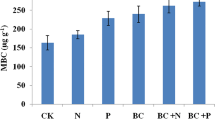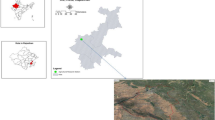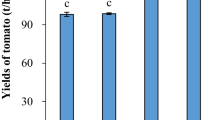Abstract
Two years consecutive field experiments were conducted at Agriculture Research Institute Mingora Swat, Pakistan in summer seasons of 2016 (year 1) and 2017 (year two) on soybean (cv. Malakand-96) crop. The design was used randomized complete block design (RCBD) with three replications. Experimental treatments were used, peach residues (leaves and fruits having no stones (partially decomposed), its well decomposed compost comprised of leaves and fruits having no stones and its biochar (peach tree stem, with peach stones, leaves and twigs), three phosphorus (P) levels and two beneficial microbes PSB and Trichoderma. Results revealed that peach organic sources and soil application of Trichoderma and phosphorous enhanced soybean phenology and yield. Days to emergence and emergence m–2 was non-significantly affected by P levels, organic sources and beneficial microbes, although number of branches and number of leaves plant–1 responded positively to organic sources, P levels and beneficial microbes application. Soybean seed yield was increased with organic sources, phosphorous levels and beneficial microbe’s inoculation. Highest seed yield was produced with compost amendments having at par valued with biochar, while P at the rate of 75 and 100 kg ha–1 produced at par value seed yield. Among beneficial microbes, soil applied Trichoderma was far better than seed inoculation with PSB. Regression analysis was carried for all the treatments and concluded that soybean seed yield increased with rest plots as compared to control.







Similar content being viewed by others
REFERENCES
Ahmad, W., Khan, F., and Naeem, M., Improvement of physical properties of eroded agricultural soils through agronomic management practices, Indian J. Agric. Sci., 2014, vol. 84, no. 7, pp. 850–855.
Ahmad, W., Shah, Z., Khan, F., Ali, S., and Malik, W., Maize yield and soil properties as influenced by integrated use of organic, inorganic and bio-fertilizers in low fertility soil, Soil Environ., 2013, vol. 32, no. 2, pp. 121–129.
Aise, D., Erdal, S., Hasanand, A., and Ahment, M., Effects of different water, phosphorus and magnesium doses on the quality and yield factors of soybean in Harran plain conditions, Pak. J. Bot., 2011, vol. 6, no. 6, pp. 1484–1495.
Akhtar, M.J., Asghar, H.N., Shahzad, K., and Arshad, M., Role of plant growth promoting rhizobacteria applied in combination with compost and mineral fertilizers to improve growth and yield of wheat (Triticum aestivum L.), Pak. J. Bot., 2009, vol. 41, no. 1, pp. 381–390.
Akpalu, M.M., Siewobr, H., Oppong-Sekyere, D., and Akpalu, S.E., Phosphorus application and rhizobia inoculation on growth and yield of soybean (Glycine max L. Merrill), Am. J. Exp. Agric., 2014, vol. 4, no. 6, pp. 674–685.
Akter, F., Nurul-Islam, M.D., Shamsuddoha, A.T.M., Bhuiyan, M.S.I., and Shilpi, S., Effect of phosphorus and sulphur on growth and yield of soybean (Glycine max L.), Int. J. Bio-Resour. Stress Manage., 2013, vol. 4, no. 4, pp. 555–560.
Alahdadi, I., Masoumeh, T., Hamid, I., and Omid, A., The effect of biofertilizer on soybean seed vigor and field emergence, J. Food Agric. Environ., 2009, vol. 7, nos. 3–4, pp. 420–426.
Ali, K., Arif, M., Islam, B., Hayat, Z., Ali, A., Naveed, S., and Shah, F., Formulation of biochar based fertilizer for improving maize productivity and soil fertility Pakistan, Pak. J. Bot., 2018, vol. 50, no. 1, pp. 135–141.
Ali, K., Arif, M., Jan, M.T., Khan, M.J., and Jones, D.L., Integrated use of biochar: A tool for improving wheat quality, nutrient uptake and soil quality under degraded soils, Pak. J. Bot., 2015, vol. 47, no. 1, pp. 34–47.
Arif, M., Muhammad, I., Muhammad, R., Kawsar, A., Kamran, S., Izhar, U.H., and Shah, F., Biochar improves phosphorus use efficiency of organic-inorganic fertilizers, maize-wheat productivity and soil quality in a low fertility alkaline soil, Field Crops Res., 2017, no. 214, pp. 25–37.
Atehnkeng, J., Ojiambo, P.S., Ikotum, T., Sikora, R.A., Cotty, P.J., and Bandyopadhyay, R., Evaluation of atoxigenic isolates of Aspergillus flavusas potential biocontrol agents for aflatoxin in maize, Food Addit. Contam., A, 2008, vol. 25, pp. 1266–1273.
Chakraborty, B. and Sujoy, H., Impact of inorganic and organic manures on yield of soybean and soil properties, Soybean Res., 2016, vol. 14, no. 2, pp. 54–62. http://eands.eands.dacnet.nic.in.
Druzhinina, I.S., Kopchinsky, A.G., and Kubicek, C.P., The first 100 Trichoderma species characterized by molecular data, Mycoscience, 2006, vol. 47, no. 2, pp. 55−64.
Gilardi, G., Manker, D.C., Garibaddi, A., and Gullino, M.L., Efficacy of the biocontrol agents Bacillus subtilis and Ampelomyces quisqualis applied in combination with fungicides against powdery mildew of Zucchini, J. Plant Dis. Prot., 2008, vol. 115, pp. 208–213.
Harman, G.E., Howell, C.R., Viterbo, A., Chet, I., and Lorito, M., Trichoderma species-opportunistic, avirulent plant symbionts, Nat. Rev. Microbiol., 2004, vol. 2, pp. 43–56.
Harman, G.E., Trichoderma for biocontrol of plant pathogens: From basic research to commercialization products, Cornell Community Conference on Biological Control, 1996. https://www.entomology.cornell.edu.shelton/cornell. Accessed October 2013.
Harman, G.E., Overview of mechanisms and uses of Trichoderma spp., Phytopathology, 2006, vol. 96, no. 2, pp. 190–194.
Herrera-Estrella, A. and Chet, I., The biological control agent Trichoderma—from fundamentals to applications, in Fungal Biotechnology in Agricultural, Food and Environmental Applications, Arora, D.K. and Dekker, M., Eds., New York: CRC Press, 2004, vol. 21, pp. 147–156.
Hjeljord, L.G., Stensvand, A., and Tronsmo, A., Effect of temperature and nutrient stress on the capacity of commercial Trichoderma products to control Botrytis cinerea and Mucor piriformis in greenhouse strawberries, Biol. Control, 2000, vol. 19, pp. 149–160.
Howell, C.R., Hanson, L.E., Stipanovic, R.D., and Puckhaber, L.S., Induction of terpenoid synthesis in cotton roots and control of Rhizoctonia solani by seed treatment with Trichoderma virens,Phytopathology, 2000, vol. 90, pp. 248–252.
Howell, C.R., Mechanisms employed by Trichoderma species in the biological control of plant diseases: The history and evolution of current concepts, Plant Dis., 2003, vol. 87, pp. 4–10.
Imran, Phosphorous fertilization influenced weeds attributes and phenological characteristics of mungbean cultivars (Vigna radiata L.), Russ. Agric. Sci., 2018, vol. 44, no. 3, pp. 229–234.
Imran and Khan, A.A., Canola yield and quality enhanced with sulphur fertilization, Russ. Agric. Sci., 2017, vol. 43, pp. 113. https://doi.org/10.3103/S1068367417020100
Imran, A., Biochar application along with phosphorous and beneficial microbes ameliorates dry matter partitioning in maize and soybean, PhD Dissertation (unpublished).
Imran, Jamal, N., Alam, A., and Khan, A.A., Grain yield, yield attributes of wheat and soil physio-chemical characteristics influenced by biochar, compost and inorganic fertilizer application, Agric. Res. Technol.: Open Access J., 2017, vol. 10, no. 4. https://doi.org/10.19080/ARTOAJ.2017.10.555795
Imran, Khan, A.A., Khan, I., and Naveed, S., Weeds density and late sown maize productivity influenced by compost application and seed rates under temperate environment, Pak. J. Weed Sci. Res., vol. 22, no. 1, pp. 169–181.
Imran, Ecological environmental variability influence growth and yield potential of rice under northern climatic scenario, Russ. Agric. Sci., 2018, vol. 44, no. 1, pp. 18–24.
Imran, Organic matter amendments improve soil health, productivity and profitability of maize and soybean, Annu. Rev. Res., 2018, vol. 1, no. 3, pp. 1–4.
Komon-Zelazowska, M., Bisset, J., Zafari, D., Hatvani, L., Manczinger, L., Woo, S., Lorito, M., Kredics, L., Kubicek, C.P., and Druzhinina, I.S., Genetically closely related but phenotypically divergent Trichoderma species cause green mold disease in oyster mushroom farms worldwide, Appl. Environ. Microbiol., 2007, vol. 73, no. 22, pp. 7415–7426.
Muhammad, A., Khan, K.S., Zaman, K.A., and Ahmad, N., Response of soybean varieties to maturity and biomass production under various planting dates, Pure Appl. Biol., 2016, vol. 5, no. 3, pp. 418–425. https://doi.org/10.19045/bspab.2016.50054
Mukherjee, P.K., Horwitz, B.A., and Kenerley, C.M., Secondary metabolism in Trichoderma—a genomic perspective, Microbiology, 2012, vol. 158, no. 1, pp. 35–45.
Paliwal, D.K., Kushawaha, H.S., Thakur, H.S., Tailor, R.S., and Deshwal, A.K., Effect of vermicompost in combination with fertilizers on nodulation, growth and yield of soybean (Glycine max) in soybean-wheat cropping system, Soybean Res., 2011, vol. 9, pp. 95–102.
Panse, V.G. and Sukatme, P.V., Statistical methods for agricultural workers, Biores. Stat. Manage., 1978, vol. 4, no. 4, pp. 555–560.
Papavizas, G.C., Trichodema and Gliocladium: Biology, ecology and potential for biocontrol, Annu. Rev. Phytopathol., 1985, vol. 23, pp. 23–54.
Samuels, G.J., Trichoderma: A review of biology and systematics of the genus, Mycol. Res., 1996, vol. 100, no. 8, pp. 923–935.
Schaster, A. and Schmoll, M., Biology and biotechnology of Trichoderma,Appl. Microbiol. Biotechnol., 2010, vol. 87, pp. 787–799.
Sharma, G.D., Rishikesh, T., and Kauraw, D.L., Impact of integrated input resource management on production and nutrient uptake of soybean [Glycine max (L.) Merrill], Soybean Res., vol. 12, no. 1, pp. 104–109.
Steyaert, J.M., Ridgway, H.J., Elad, Y., and Stewart, A., Genetic basis of mycoparasitism: A mechanism of biological control by species of Trichoderma,J. Crop Hortic. Sci., 2003, vol. 31, pp. 281–291.
Thakur, R., Sawakar, S.D., Vaishya, U.K., and Muneshwar, S., Impact of continuous use of inorganic fertilizers and organic manure on soil properties and productivity under soybean-wheat intensive cropping of Vertisol, J. Indian Soc. Soil Sci., 2011, vol. 59, no. 1, pp. 74–81.
Vinale, F., Sivasithamparam, K., Ghisalberti, L.E., Marra, R., Woo, L.S., and Lorito, M., Trichoderma-plant-pathogen interactions, Soil. Biol. Biochem., 2008, vol. 40, pp. 1–10.
Waghmare, Y.M., Kalegore, N.K., Jadhav, S.G., Waghmare, P.K., and Desai, M.M., Effect of integrated nutrient management on yield attributes, yield and quality of soybean [Glycine max (L.)], Proceedings of ‘Soycon-2014, International Soybean Research Conference on Mitigating Productivity Constraints in Soybean for Sustainable Agriculture, 2014, p. 167.
Yaqub, F. and Shahzad, S., Effect of seed pelleting with Trichoderma spp., and Gliocladium virens on growth and colonization of roots of sunflower and mugbean by Sclerotium rolfsii,Pak. J. Bot., 2008, vol. 40, no. 2, pp. 947–963.
Yedidia, I., Shoresh, M., Kerem, Z., Benhamou, N., Kapulnik, Y., and Chet, I., Concomitant induction of systemic resistance to Pseudomonas syringae pv. lachrymans in cucumber by Trichoderma asperellum (T-203) and accumulation of phytoalexins, Appl. Environ. Microbiol., 2003, vol. 69, pp. 7343–7353.
Author information
Authors and Affiliations
Corresponding author
Ethics declarations
The authors declare that they have no conflict of interest. This article does not contain any studies involving animals or human participants performed by any of the authors.
About this article
Cite this article
Imran, Amanullah, Arif, M. et al. Integration of Peach (Prunus persica L.) Residues, Beneficial Microbes and Phosphorous Enhance Phenology, Growth and Yield of Soybean. Russ. Agricult. Sci. 46, 223–230 (2020). https://doi.org/10.3103/S1068367420030064
Received:
Published:
Issue Date:
DOI: https://doi.org/10.3103/S1068367420030064




